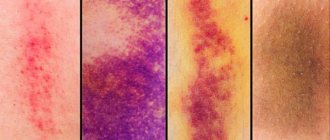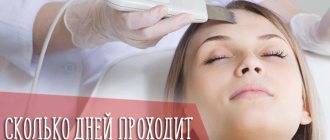General information
The name of the disease is due to the fact that outwardly it looks like a nettle burn - the skin turns pink and swells, while small blisters can merge into large local spots (angioedema) of irregular shape.
Papules cause itching and discomfort; when scratched, the wound surface can become infected, and then dermatitis and other complications join the underlying disease. The disease is very common; every third person on the planet has suffered from urticaria in one form or another.
Symptoms of urticaria in children
The main sign of urticaria in a child is a rash. Its prevalence and severity may vary, but in most cases the disease follows a single pattern.
- Convex pink and red rashes appear that turn pale when the skin is pressed or stretched. When the blisters merge, the edges of the spots become more intensely colored.
- The appearance of blisters, their disappearance or merging into vast shapeless foci occurs chaotically, and their migration over the surface of the body is unpredictable.
- The rash is accompanied by severe itching.
- The temperature may rise, either slightly or to high values.
- Often - weakness, malaise, joint pain and headache.
- In the complicated form, difficulty breathing or swallowing, nausea and vomiting, and bowel movements.
- An even more severe manifestation is angioedema on the lips, oral mucosa, eyelids, cheeks or genitals.
The localization of the appearance of the rash can be anywhere, including on the mucous membranes - lips, nasopharynx, ears and genitals. Most often, the upper part of the body and arms are affected, while the symmetry of the rashes is not always present; the spots take on the most bizarre coral-like shapes.
In most cases, allergies in the form of urticaria in children are accompanied only by the appearance of an itchy rash, which does not last long, from several hours to several days. Often other pathologies give similar symptoms; in this case, urticaria is not considered as an independent disease.
Information for parents! If a rash in the form of hives is accompanied by even slight swelling in the child, especially in the face and neck, you must immediately call emergency help!
Do you need to treat hives with medication or will it go away on its own?
No, hives cannot go away on their own. This disease requires a diet and elimination of contact with various substances that can cause redness and allergies.
If the child has no complications, the disease does not require special treatment, but the doctor may prescribe antiallergic drugs such as diazolin, claretin and many others. They relieve symptoms, alleviating the general condition, but do not treat the cause.
During treatment, exclude red caviar, chocolate, all types of nuts, foods with food coloring or medications.
To exclude non-food allergies, it is worth replacing soap, shower gel and shampoo with analogues with a more natural composition.
How not to die from Quincke's edema, watch this video:
Will the rash go away on its own over time? Yes, such cases happen. Usually, after 5 years of age, a child can already eat those foods to which he was allergic at an earlier period. But there are cases when intolerance to one product remains for life.
Is it contagious or not?
No, the child can fully communicate with children if the diagnosis is made correctly.
Is it possible to walk with this disease?
Not only is it possible, but it is also necessary. But preferably in the fresh air. Then your baby will feel better, which will strengthen his immunity.
An exception may be frost if hives appear on the face. It is better to carefully lubricate it with a low-fat cream before a walk.
Causes of urticaria in children
There can be many reasons for the appearance of hives in a child. In addition, it can be caused by different factors in the same person at different ages. Among the most common pathogens in children, the following groups can be distinguished:
- Food products (citrus fruits, nuts, eggs, seafood, strawberries, tomatoes, etc.).
- Food additives, primarily sulfides, salicylates and various chemical dyes.
- Household allergens (dust, fluff, cigarette smoke, pollen, cosmetics and detergents, synthetic clothing, fumes from furniture varnishes, paints, etc.).
- Medicines and contrast agents for radiography.
- Blood (donated) and drugs created on its basis.
- Vaccinations.
- Insect bites, helminthic infestations.
- Physical, including thermal phenomena (overheating and sweating, cold, physical activity, direct sunlight).
- Psychogenic factors.
- Various infections.
All of these factors can become both the cause of primary urticaria and the impetus for its exacerbation during the chronic course of the disease. In children under two years of age, the vast majority of cases of urticaria are caused by food allergens.
Causes of the disease
Allergic urticaria is one of the types of general pathology: urticaria (urticaria), which, in addition to the allergic mechanism, may have another pathogenesis. The causes of the development of urticaria are divided into exogenous (the influence of external factors) and endogenous (internal).
Exogenous:
- food products – nuts, eggs, fish and seafood, citrus fruits;
- medicines – antibiotics, drugs based on acetylsalicylic acid, non-steroidal anti-inflammatory drugs;
- transfusion of blood and its components;
- chemical – household chemicals, cosmetics;
- physical – cold, high temperature, sun, water;
- insect bites.
Endogenous:
- stress;
- general internal diseases;
- viral infections;
- helminthic infestations.
Often the cause of the development of pathology remains unknown. 90% of cases of the chronic form are of unclear origin.
The causes of allergic urticaria are most often a reaction to food, medications, or an immune response to the effects of toxins released during internal diseases.
The mechanism of occurrence of urticaria (pathogenesis)
The human body contains mast cells or mast cells, which are specific elements of connective tissue. They are the central element in the development of urticaria, activators of inflammation. When an allergen enters the body for the first time and in small doses, the child does not experience any external manifestations or reactions, but sensitization occurs, which can be represented as the first acquaintance with the allergen, resulting in the production of histamine. It is this substance that causes redness, swelling and other inflammatory factors. It gradually accumulates in mast cells, and when its amount reaches a critical threshold, the cell membrane is destroyed with the release of histamine into the bloodstream and a subsequent cascade of pathological changes in the body.
Classification of urticaria in children
According to the nature of the course, acute and chronic forms are distinguished.
In the first case, the disease manifests itself abruptly; the symptoms of urticaria continue to bother the child from several hours (usually 6-12) to 1-2 weeks. The rash is accompanied by severe itching, the surface of the skin at the site of the rash becomes hot to the touch. If the outbreak is caused by an allergen, then when contact with it is eliminated, the symptoms disappear quickly and without a trace. With an exacerbation of chronic urticaria, the itching and rashes are less intense, but in this case they can persist for a long period - several weeks and sometimes months. The condition is accompanied by weakness, nausea, loss of appetite, headaches, and, less commonly, stool disorders. Sometimes, against the background of sluggish urticaria, neurotic disorders develop, and since the child constantly scratches the itchy papules, a secondary infection occurs and dermatitis develops.
Based on the severity of the disease, the following types of urticaria in children are distinguished.
- Mild form - external manifestations are almost invisible, the child feels well, there is no itching or intoxication of the body. A minor rash goes away within a day at most.
- Moderate - characteristic rashes are clearly visible, accompanied by fever and itching; intoxication of the body in the form of nausea and headache may be present. The papules merge, swelling appears, and there is a risk of the first signs of Quincke's edema appearing.
- Severe - pronounced symptoms. Severely itchy rash, general intoxication of the body with a gastrointestinal reaction, development of Quincke's edema. Requires urgent medical attention.
Depending on the provoking factor, the child may experience the following types of urticaria:
- Contact - has an allergic origin, in 1st place among the causes are pharmacological and biological factors. When contact with them is eliminated, it goes away without a trace.
- Idiopathic - occurs for unknown reasons. It does not respond well to standard treatment and retains symptoms for a long time.
- Vibration - occurs against a background of strong mechanical vibrations.
- Dermatographic - provoked by mechanical irritation of the skin (tight or synthetic clothing, skin folds, etc.). After eliminating the irritant, it goes away very quickly, usually within half an hour.
- Cholinergic - caused by high physical activity, characterized by the appearance of small rashes.
- Thermal - provoked by uncomfortable (high or low) ambient temperature. Accompanied by particularly severe itching and is the most common cause of edema.
- Aquagenic - a reaction to contact with water. The rash is usually small or absent, but is accompanied by severe itching.
Temperature urticaria
As with the types of urticaria described above, the child follows a diet according to A.D. Ado. You should adhere to a gentle thermal regime, avoiding high and too low temperatures. If the effect of thermal factors on the body is inevitable, antihistamines should be taken before contact. In cases of photodermatosis, photosensitizing drugs are discontinued.
For the generalized form, take clemastine 0.1% 2 ml, chloropyramine (suprastin) 2.5%, dexamethasone, prednisone. For mild to moderate cases, take fexofenadine and loratadine once a day. Doctors may also prescribe antihistamines with a stabilizing effect on mast cell membranes.
First aid for urticaria in a child
The primary task is to identify and eliminate the provoking factor. The main problem during this period is not rashes, but itchy skin. When providing first aid, it is important to eliminate it if possible - gently trim the nails, put on protective gloves for infants, apply an available non-hormonal anti-allergic cream (for sunburn, mosquito bites, etc.) to the site of the rash. If there is no cream, you can use a cool compress.
All this is done before medical assistance, which should be provided immediately. In case of development of edema and severe symptoms, it is necessary to call an emergency team.
Treatment of urticaria in children
The choice of treatment tactics for urticaria in children depends on its cause, main symptoms, the age of the child, as well as the stage at which the disease is caught.
Only a doctor can prescribe complete therapy after an accurate diagnosis. The main goals include eliminating precipitating factors, prescribing medications to eliminate symptoms, and treating associated pathologies. The doctor makes the choice of antihistamines and other drugs based on the individual clinical picture. Modern medicine offers new generation drugs that minimize the risk of side effects, have a high level of safety and are easy to use for young children. In severe cases, hospitalization may be required.
Is it possible to bathe a child with hives?
If the disease is not aquagenic in nature, you can and should bathe your child, but it is important to follow the recommendations:
- do not heat the water above +37C;
- do not use washcloths and hygiene products with dyes and fragrances;
- maximum bathing time - 10 minutes;
- the use of herbal decoctions and potassium permanganate should be agreed with a doctor;
- Do not rub the inflamed skin with a towel.
How long does urticaria last in a child?
Hives signal themselves with red spots, reminiscent of multiple mosquito bites. They may swell and merge with each other, creating large red spots.
Usually the doctor asks for tests to rule out various infections. But even if they were not detected, this does not mean that the disease is not dangerous. If urticaria is not treated in time, it can lead to very dangerous consequences for the child’s health.
What danger does this disease pose?
Hives occur when a substance enters the body and is rejected by the immune system. First of all, it occurs on fruits, berries, new complementary foods or dyes in clothes or animal fur.
To understand what causes the disease, remember what you ate the day before the rash. Try stopping this product and see what happens. Usually, red spots begin to fade immediately when a person stops eating the allergen.
But if you continue to feed your child foods that cause allergies, this can lead to bad consequences. First of all, urticaria is dangerous due to the following complications:
- Quincke's edema, allergic cough. The child begins to choke and has to call an ambulance;
- anaphylactic shock, which often leads to loss of consciousness;
- secondary skin infection. If a child scratches the spots, they cause discomfort, and the likelihood of an infection developing due to an allergy increases, which will be more difficult to cure.
In almost all cases, urticaria is caused by eating red foods: currants, raspberries, tomatoes, strawberries, apples or citrus fruits. The abolition of these products helps the red spots begin to fade noticeably.
What influences recovery
The duration of the disease is determined by the time during which the child consumed foods with the allergen, the severity of the lesion, and the general state of the immune system.
Typically, severe cases of allergic dermatitis resolve within a few weeks of stopping the offending product.
In severe cases, if the child has had angioedema, anaphylactic shock or an allergic cough, urticaria may go away within 6 weeks. Recovery may occur faster if the child follows the urticaria diet prescribed by the doctor.
This video will tell you how to diagnose urticaria in a child:
If the disease does not go away within 2 months, it is probably chronic urticaria. It can last for a very long time, especially if the child switches from breastfeeding to regular food.
In this situation, much depends on the presence or absence of a secondary infection, the child’s general immunity and the severity of previous infectious diseases.
The healing process depends on how long the contact with the allergen was and how the immune system reacted to it. After stopping a number of foods that can cause hives, recovery occurs within a few days or weeks.
Possible complications and their consequences
Urticaria, despite its apparent harmlessness, can lead to serious consequences, primarily to Quincke's edema. Its characteristic initial symptoms, in addition to the swelling itself, are difficulty breathing and paroxysmal cough with whistling (bronchospasms). Swelling of the internal mucous membranes is dangerous due to disruption of the housing and communal services, the first signs of which are a gag reflex and stool disturbance. From the nervous system, severe cases of urticaria are dangerous due to damage to the meninges, which can be fatal in the absence of medical assistance.
Treatment of urticaria in children
It is impossible to predict the body's reaction to a particular allergen, however, every parent can protect their child as much as possible from contact with the most active well-known allergens, do not bundle up or overcool, and do not use cosmetics and detergents with dyes and strong fragrances.
If possible, prevent the presence of children in rooms with a strong smell of paints and varnishes, avoid stress, infections and excessive physical exertion. It is recommended to examine the child’s endocrine system and not ignore signs of weak immunity. Unfortunately, urticaria is often not taken seriously; however, it is a disease that, if unfavorable, can threaten the life of a child.
SM-Doctor pediatricians are always ready to help your child; their experience and attentive attitude to each little patient are the key to a quick and correct diagnosis and well-chosen treatment tactics.
Diagnosis of the disease
First of all, the doctor conducts an anamnesis and examination. In a conversation with the patient, the doctor will clarify the time of appearance of the first rashes, the reasons preceding their occurrence, how long it takes for the blisters to resolve, what else worries the patient, what concomitant pathologies are present, which countries the person has visited recently, whether there have been any insect bites.
During the examination, in addition to the type and location of the rash, the doctor will be interested in the condition of the lymph nodes, the presence or absence of swelling in the joint area, and whether the liver and spleen are enlarged.
To identify the allergen, blood tests (general, biochemical), skin or injection allergy tests are prescribed. Source: Clinical and laboratory features of the course of urticaria. Prokofieva N. B. Dermatovenereology. Cosmetology. Sexopathology, 2011. p. 30-35.
If there is a suspicion that urticaria is caused by physical factors, provocative tests are performed. These are mechanical irritation of the skin, physical activity, hot bath, ice cube test, water compress, photo testing, weight hanging test.








